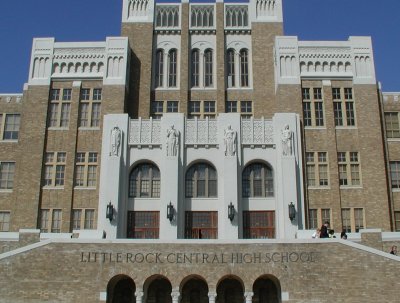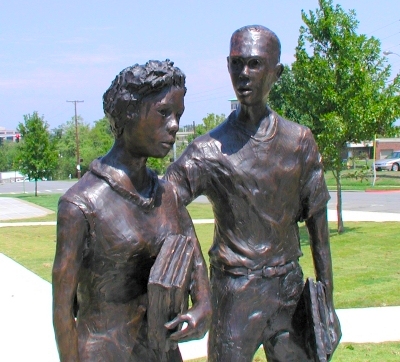Little Rock Central High School

Little Rock Central High School was completed in 1927 and originally was called Little Rock High School. It cost $1.5 million to build, and The New York Times declared during its construction that it was the most expensive school building ever constructed in the United States. Even before it was completed, Little Rock High School was named "America's Most Beautiful High School" by the National Association of Architects, a title that had not been bestowed upon another high school before then and has not been conferred to another high school since. At the time it was built, it was the largest high school in the country, a record it held until the late 1940s. It was renamed Little Rock Central High School in 1955 when construction began on Hall High School in western Little Rock.
Jim and Judy Lester describe the school's location in their book Greater Little Rock: "Little Rock's largest park in the late nineteenth century was West End Park, covering a six-block area between Fourteenth Street, Sixteenth Street, Park Avenue and Jones Street. The site of West End Park eventually became the home of Little Rock Central High School." Central traces its origins back to 1869 when the Sherman School began operation in a wood structure at 8th and Sherman Streets, but it was not until June 13, 1873, that the school produced its first graduating class. In 1885 the school moved to 14th and Scott Streets and was named Scott Street School but was commonly called City High School. In 1890 Peabody School was built at West Capitol and Gaines streets. It was named in honor of philanthropist George Peabody who donated millions of dollars to Southern states after the Civil War for building schools; Little Rock received nearly $200,000. In 1905 Little Rock High School opened at 14th and Cumberland streets. The high school remained in that location until 1927 when it moved into the current building at 14th and Park streets. Extensive national publicity was afforded Little Rock High School when the new building was completed. "We have hundreds of journalists in our fair city for the dedication," read an article in the Arkansas Gazette.

Little Rock Central High boasts impressive statues of four figures over the front entrance. They represent Ambition, Personality, Opportunity and Preparation. At the 1927 dedication service Lillian McDermott, then the president of the School Board, claimed that the new school "would stand...for decades to come [as] a public school where Ambition is fired, where Personality is developed, where Opportunity is presented and where Preparation in the solution of life's problems is begun."
Central High School was the center of a struggle for desegregation that garnered national and worldwide media attention in 1957. Arkansas Governor Orval Faubus, President Dwight D. Eisenhower, the court system and the military all were players in a drama surrounding nine African-American students who tried to attend the then all-white school. After the Brown v. Board of Education ruling in 1954, which stated that "separate but equal" was not providing an equal education for African-American students, the Little Rock Board of Education decided to integrate its schools. In September 1957 hostilities arose over the admission of the nine students (who became known as the "Little Rock Nine") to Central. President Eisenhower was compelled to use troops from the U.S. Army's 101st Airborne Division to escort the students into the school. His action was the first time since the post-Civil War Reconstruction period that federal military force was used to support African-American civil rights. Federalized Arkansas National Guard troops remained at the school for the rest of the school year. Inside the school teachers and students tried to carry on as usual while a small group of white students constantly harassed the nine African-American students. While the NAACP pursued the matter through the courts in the summer of 1958, Governor Faubus signed a bill into law allowing him to close all four of Little Rock's public high schools to prevent further desegregation efforts. Two weeks later Little Rock's citizens voted against the immediate integration of all of the district's schools, and the high schools remained closed for the duration of the 1958-59 school year. Students did have some options for their education: some students managed to enroll in high schools in nearby school districts; some enrolled in private schools; some went to live with relatives out of town or out of state; some took correspondence courses; some seniors managed to obtain early admission to college; and some students unfortunately did not pursue their education at all during this year. The 1958-59 school year is commonly referred to in Little Rock as the "Lost Year." In May 1959 three of the six School Board members voted not to renew the contracts of 44 teachers and administrators who they felt had supported desegregation. This move prompted the city's leaders to act, and a campaign to recall the three segregationist School Board members succeeded. In the fall of 1959 a newly constituted School Board reopened the high schools under the existing desegregation plan.

See a timeline of the desegregation crisis from 1954 to 1957 HERE.
See a timeline of the desegregation crisis in 1958 HERE.
See a timeline of the desegregation crisis in 1959 HERE.
See biographical sketches of the Little Rock Nine HERE.
More than 50 years after the "crisis at Central High," the student body of over 2,000 is approximately 55% African American.
The United States Postal Service honored the Little Rock Nine in August 2005 with a commemorative stamp; it was one of ten stamps in the "To Form a More Perfect Union" series that remembers a variety of civil rights milestones. The stamp is based on George Hunt's painting "America Cares" (1997). A bronze memorial on the grounds of the Arkansas State Capitol was unveiled the same day that also honored the Little Rock Nine. Named "Testament," It consists of life-size bronze figures of the nine students and quotes from each on bronze plaques. It is the first civil rights memorial to be placed on the grounds of a state capitol in the United States. The memorial was designed by Little Rock artists Kathy and John Deering.
The United States Mint also has honored the Little Rock Nine with a commemorative silver dollar. Issued in July 2007, the obverse (front) of the coin features a view of the feet of the students, escorted by a United States soldier, walking toward school below a row of nine symbolic stars. The reverse of the coin features a rendition of Little Rock Central High School as it appeared in 1957.
Central High School is listed on the National Register of Historic Places (1977). It was designated a National Historic Landmark in 1992 and a National Historic Site by then-President Bill Clinton in 1998. In 1997 the National Park Service opened the Central High Museum and Visitor Center on the corner of Park Street and Daisy L. Gatson Bates Drive in a converted gas station restored to its 1950s appearance, and the Central High Commemorative Garden was dedicated in 2001. In 2004 the National Park Service and the Little Rock School District restored the reflecting pool that originally was in front of the school.

Some additions to Central include: Quigley Stadium in 1937 (LRSD purchased Civitan Park in 1926 from the City of Little Rock for this purpose), the field house in 1950, dressing rooms in 1965, the library building in 1969 and the choral room in 1973.
Quigley Stadium is named for Earl Quigley, a coach for the Tigers from 1914 to 1935. When it was constructed in 1936, it was the largest stadium in the state and one of the largest in the South. Many college and university football teams, including the Arkansas Razorbacks, played there until Little Rock's War Memorial Stadium was dedicated in 1948. It was not unusual for the Tigers to draw larger crowds to Quigley Stadium than the Razorbacks.
Little Rock High School was the original home of Little Rock Junior College, which began in 1927 with approximately 100 students. In 1931 it moved to the former U.M. Rose Elementary building at 13th and State streets (on the present-day Philander Smith College campus), then it moved again during the 1948-49 school year to an 80-acre tract of land on Hayes Street (now University Avenue). The school district divested itself of the junior college in 1957 to a private board of trustees. Little Rock Junior College expanded its curriculum and changed its name to Little Rock University the same year, becoming a four-year institution. It merged with the University of Arkansas system in 1969 and became the University of Arkansas at Little Rock.

Central offers students an international studies magnet program and an extensive curriculum including more than 30 Advanced Placement (AP) courses. Central consistently has more National Merit Semifinalists than any other school in the state (19 in 2006-07 alone), claims a large percentage of the state's National Achievement Semifinalists (approximately 20% of Arkansas' total between 1994 and 2004) and has produced 15 Presidential Scholars since the program's inception in 1964. Central received academic accreditation in its first year and holds the oldest charter of the Cum Laude Society--a national academic achievement organization--west of the Mississippi River. Central's students participate in festivals and competitions in all academic and artistic areas and are recognized within Arkansas and around the country for their work. In addition to the construction projects noted above, an extensive internal and external renovation project began on the building in 2002.
Sources:
LRSD archives.
Lester, Jim; Lester, Judy: Greater Little Rock. Norfolk, Va.: The Donning Co., 1986.
"Constitutional Writes," the official newsletter of Little Rock Central High School National Historic Site. Summer 2003; vol. 1, issue 1.
"Little Rock 1957: Pages from History,"
Application for placement on National Register of Historic Places [U.M. Rose School]. Obtained from the Department of Arkansas Heritage, 1500 Tower Bldg., 323 Center St., Little Rock, AR, 72201.
National Park Service web site;
"Public Buildings: American Images" web site, page for Central High School
"From Canterbury to Little Rock: The Struggle for Educational Equality for African Americans" web page, a National Park Service web site
Little Rock Central High School web site
"High School History, Little Rock Arkansas, by Paul D. Snodgrass" web page, posted for the reunion of the LRHS Band in 2000; information was taken from a Class of 1948 reunion book (provides historical information about the school):
"History of UALR" web page, University of Arkansas at Little Rock:
"Closed College Index, Arkansas" (web page from R. Brown of Westminster College in Missouri, charting colleges and universities in Arkansas that no longer are operating):
United States Mint Onling Catalog, Central high School coin page
If you have information about a Little Rock school or photographs that you would like to contribute to this project (we will return photographs if requested), please contact us!
Updated October 2010
